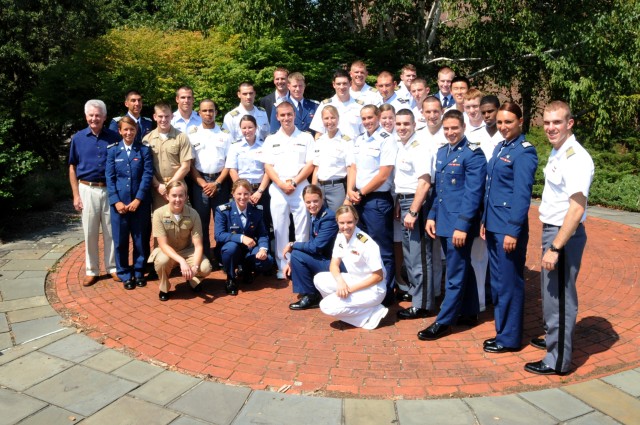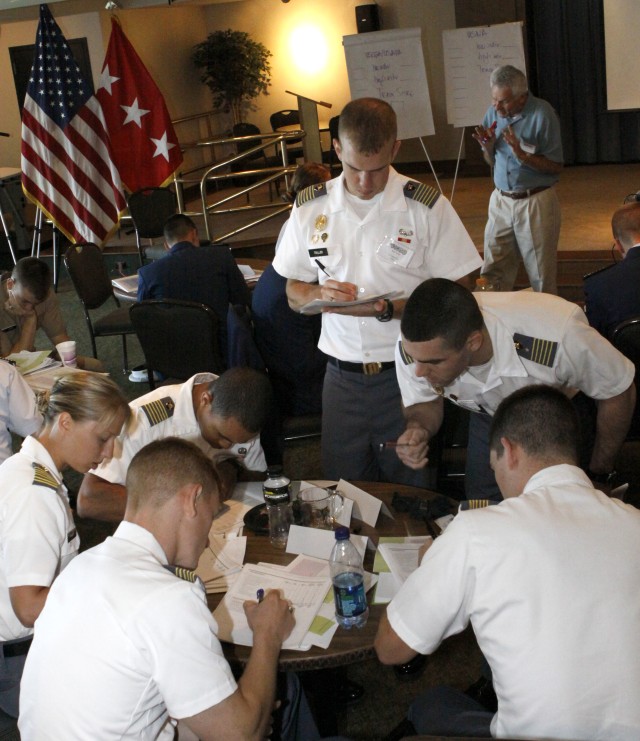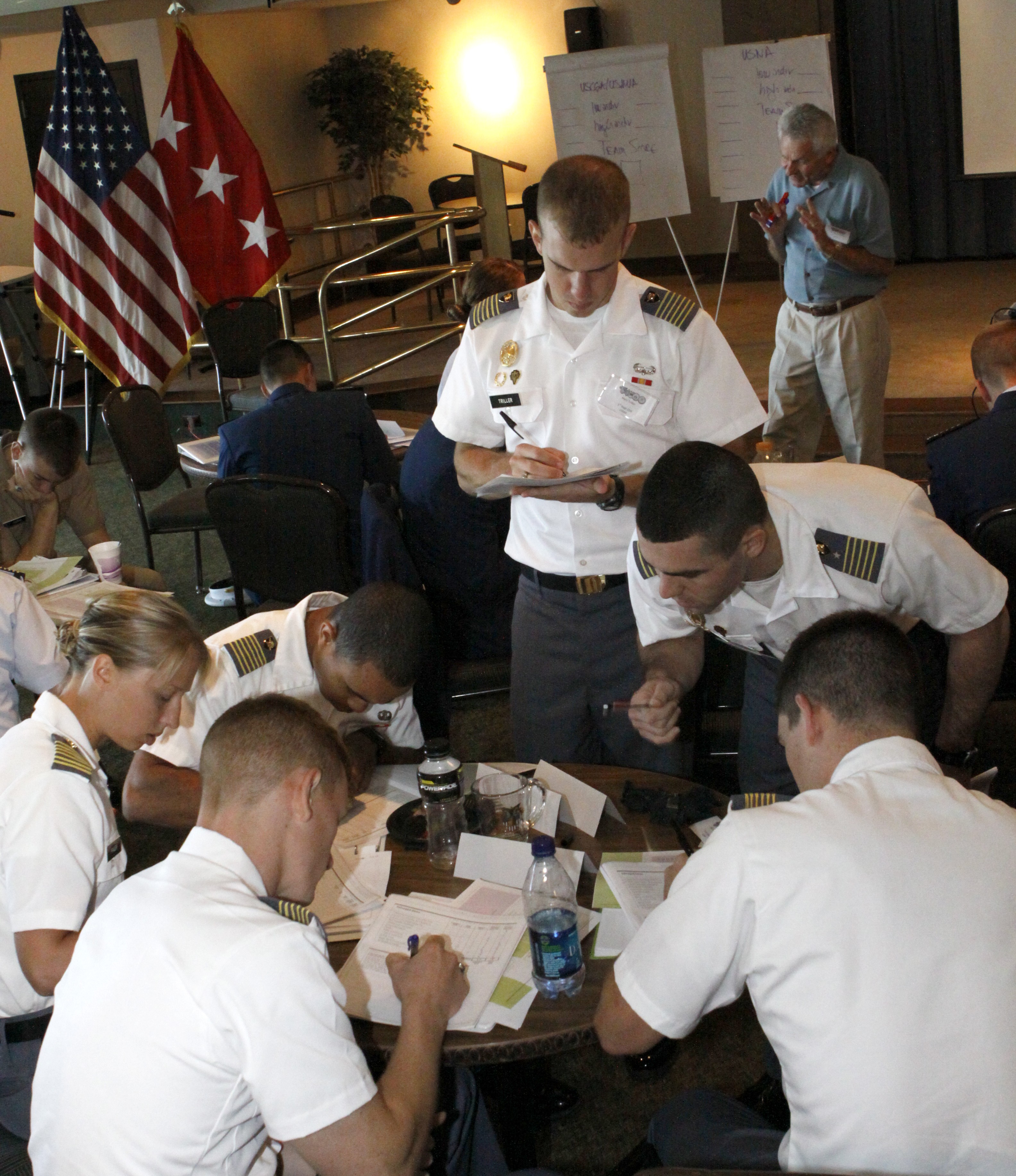WEST POINT, N.Y. (Sept. 8, 2010) -- In the realm of collegiate competition, the service academies stand divided. But as future military officers, cadets and midshipmen also have opportunities to bond and learn from each other.
The 29th annual Robert T. Stevens Service Academies Leaders' Conference is one of those forums where academy counterparts can compare notes and explore contemporary leadership challenges.
The conference offers self-assessment tools and insight into group dynamics through practical exercises, with a little friendly competition among the academies to keep things interesting.
"I found it to be generally less competitive and more professional," Firstie Nathan Hedgecock said. "I think we all understood the bigger picture and we're all working toward getting better as individuals, teams and academies."
The deputy brigade commander was among 30 senior-ranking cadets and midshipmen from all five service academies attending the annual leadership laboratory Aug. 29-Sept. 1.
"I think the most interesting thing about the conference was how much time we spent on becoming more self-aware individuals, which is great because it is a huge aspect of leadership," Hedgecock said.
One self-assessment, the MBI-or Myers-Briggs Instrument-was used to determine personality traits, which can either enhance or derail a group's synergy.
Retired Lt. Col. Barry Berglund, conference facilitator, said that while these tests reveal more about individuals, the results show how they will function as leaders and what they need to improve to function better within a team.
Berglund, a leadership development professional and honorary senior fellow at the Center for Creative Leadership, spoke about the importance of knowing oneself.
"You can't know your people until you know yourself, and everyone is different," Berglund said.
Having taught this to military students and senior leaders of all ranks across the armed forces, Berglund said it's a lesson worth revisiting.
"It has great durability but it's also an opportune thing at certain intervals to repeat and see how you're doing," Berglund said.
Berglund said he took over the Stevens program at West Point in 1993 from Col. Dandridge M. Malone, who literally wrote the book on small unit leadership. Berglund was working at the Center for Creative Leadership, when his boss, and former Commandant of Cadets, Lt. Gen. Walter Ulmer, recommended him for the job. Berglund's son, Morgan, was a Plebe at the time.
Over time, the program has evolved, yet the basic thesis remains the same. Learning about personality profiles, temperaments, group dynamics and social behaviors are always relevant when examining the intricate wiring of a leader, Berglund said.
"We center on self-awareness as a foundation of effective leadership and present an opportunity for the cadets to look at themselves as a leadership team," he said.
One of the more recent developments in the program has participants sharing challenges faced at their respective academies; while one service academy team picked out the biggest concerns facing their school, the others served as a panel to offer solutions based on their own experiences dealing with that issue.
The point of the exercise, Berglund said, is not about solving the problem, but developing dialogue between leadership teams, discussing the issue and understanding that no one service academy has all the right solutions.
"This will become important when they become commissioned officers and when they begin working across the services," Berglund said. "Some of them, 25 years from now, are going to be four-star generals or admirals, and they're going to be in the Pentagon solving some global international problem. And where will they have first had an opportunity to work together' Right here at the Stevens Conference."
The Naval Academy's Brigade Chief of Staff Laura Ramsey and Brigade Operations Officer Tony Rush both attended a semester at West Point last fall in the academy exchange program and were able to reconnect with their cadet counterparts at the Stevens Conference. It was the first time for both meeting with members of all service academies, and they left with a better understanding about their colleagues.
"We all have the same jobs, just at different academies," Ramsey said. "It's encouraging knowing that they're the 'best of the best' from their academies, so maybe we can learn something from them and they can learn something from us."
At the conclusion of the conference, they collected material to share with their brigade commander who was unable to attend.
"That right there tells me more than anything else that this program works and they've learned something today," Berglund said.
It's also the reason Berglund returns to West Point every year, having traveled across the country and even overseas at times to facilitate the conference.
At the conclusion of the conference, Berglund told the participants that it is a proud tradition in the military trade to give back; a unique bond between those who've served supporting those who are serving.
"I was asked the question the other day about how long I planned on doing this," Berglund said. "I said I'm going to get to the point where I'm not going to do any programs except the Stevens program, and I'll probably do that until I decide to retire because it's the most important program."




Social Sharing